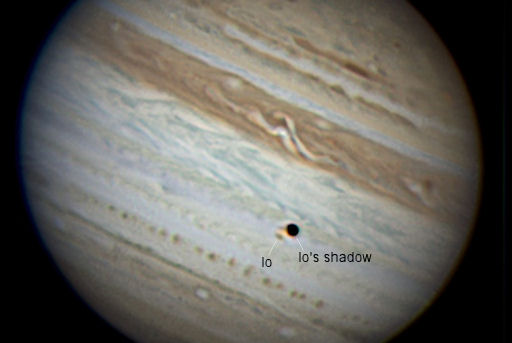| . |
If Jupiter is up at midnight, it must be opposite the sun: diagram. Indeed, astronomers call this "Jupiter's night of opposition." The effect of opposition may be seen in the shadow of Jupiter's moon Io, shown here in a photo taken last night by Anthony Wesley of Australia:
"Io was almost on top of its own shadow," points out Wesley. "This is due to the near-perfect alignment of Jupiter, Earth and the sun."
In a coincidence of interplanetary proportions, Uranus is also at opposition tonight. This rare double opposition of two giant planets is a once-in-a-lifetime event. Unlike Jupiter, Uranus is barely visible to the naked eye, a result of its smaller size and greater distance. It looks great, however, through a small telescope. Just point your optics at Jupiter and you will find emerald Uranus about 1o away.
more images: from Alan Friedman at the Mt. Wilson Observatory in California; from Pete Lawrence of Selsey, West Sussex, UK; from Efrain Morales Rivera of Aguadilla, Puerto Rico; from Sadegh Ghomizadeh of Iran Tehran; from Jerôme Grenier of Paris, France; from Frank Olsen of Tromvik, Norway; from Jimmy Eubanks of Boiling Springs, SC; from Mark Humpage of Lutterworth, UK; from P. Nikolakakos of Sparta, Greece; SPACE STATION RADAR ECHO: The US Air Force Space Surveillance Radar is scanning the skies above the USA for Earth-orbiting objects. Yesterday, Sept. 19th at 16:09 UT, the International Space Station flew through the radar's primary beam, producing a strong echo. Click on the dynamic spectrum to listen: BUSCARLO EN LA DIRECCION
"SpaceWeather.com"
The sound you just heard came from the loudspeaker of a receiver in Roswell, New Mexico, operated by radio engineer Stan Nelson. "The ISS was passing over Lubbock, Texas--midway between me and the Air Force radar," he says. "It was the perfect geometry for catching the echo."
As the ISS raced through the radar beam at 17,000 mph, its velocity vector rotated with respect to the transmitter below. That's why the echo sounds like the frequency-shifting whistle of a passing train. It's the Doppler effect, working in space the same way it does on Earth.
The space station will be making more passes through the radar beam in the days ahead. Next up: Sept. 24 @ 2142 UT (1642 CDT). Tune in to SpaceWeather Radio for live echoes.
UPDATED: Sept. 2010 Northern Lights Gallery
[previous Septembers: 2009, 2008, 2007, 2006, 2005, 2004, 2002, 2001, 2000]
[previous Septembers: 2009, 2008, 2007, 2006, 2005, 2004, 2002, 2001, 2000]
| Near Earth Asteroids |
On September 20, 2010 there were 1145 potentially hazardous asteroids.
Recent & Upcoming Earth-asteroid encounters:
| Asteroid | Date(UT) | Miss Distance | Mag. | Size |
| 2010 RF12 | Sep 8 | 0.2 LD | 28 | 9 m |
| 2010 RJ53 | Sep 9 | 8 LD | 24 | 69 m |
| 2010 RS80 | Sep 9 | 2.2 LD | 26 | 23 m |
| 2010 RM82 | Sep 10 | 2.2 LD | 26 | 31 m |
| 2009 SH2 | Sep 30 | 7.1 LD | 25 | 45 m |
| 1998 UO1 | Oct 1 | 32.1 LD | 17 | 2.1 km |
| 2005 GE59 | Oct 1 | 77 LD | 18 | 1.1 km |
| 2001 WN5 | Oct 10 | 41.8 LD | 18 | 1.0 km |
| 1999 VO6 | Oct 14 | 34.3 LD | 17 | 1.8 km |
| 1998 TU3 | Oct 17 | 69.1 LD | 15 | 5.3 km |
| 1998 MQ | Oct 23 | 77.7 LD | 17 | 1.9 km |
| 2007 RU17 | Oct 29 | 40.6 LD | 18 | 1.0 km |
| 2003 UV11 | Oct 30 | 5 LD | 19 | 595 m |
| 3838 Epona | Nov 7 | 76.8 LD | 16 | 3.4 km |
| 2005 QY151 | Nov 16 | 77.7 LD | 18 | 1.3 km |
| 2008 KT | Nov 23 | 5.6 LD | 28 | 10 m |
| 2002 EZ16 | Nov 30 | 73.9 LD | 18 | 1.0 km |
| 2000 JH5 | Dec 7 | 47 LD | 17 | 1.5 km |
LA NASA.



No hay comentarios:
Publicar un comentario